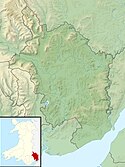Partly-restored windows facing the Pitched Stone Court, Raglan Castle - geograph.org.uk - 1531734
When Civil War broke out in the 1640s, Henry Somerset, Marquess of Worcester, was a staunch supporter of King Charles. Even after most towns and castles in England and Wales had fallen to the Parliamentarians, Raglan held out for the King. After a siege lasting months, the Marquess was compelled to surrender the castle to to General Fairfax on 19 August 1646. Much of the castle was destroyed at this time: despite this, much of the hexagonal Great Tower and the lavish suites of apartments survive.
Formerly conserved and managed by the British government's Board of Works (later English Heritage), the site is now cared for and run by Cadw (the historic environment service of the Welsh Assembly Government). Raglan Castle is open to visitors throughout the year.Relevante Bilder




Relevante Artikel
Raglan CastleRaglan Castle ist eine Burgruine in Monmouthshire in Wales. Die als Kulturdenkmal der Kategorie Grade I klassifizierte und als Scheduled Monument geschützte Ruine liegt nördlich des Dorfes Raglan. Die erst im 15. Jahrhundert errichtete Burg war eine der letzten als Burg erbauten Befestigungen in Großbritannien, diente jedoch von Anfang an auch als repräsentatives Statussymbol. .. weiterlesen
